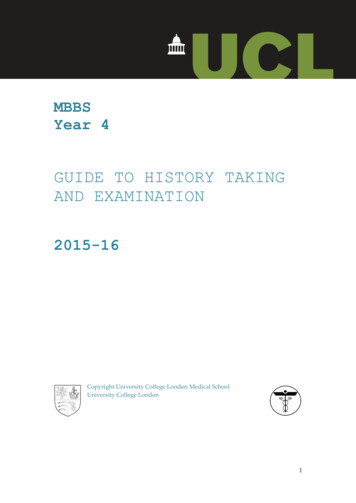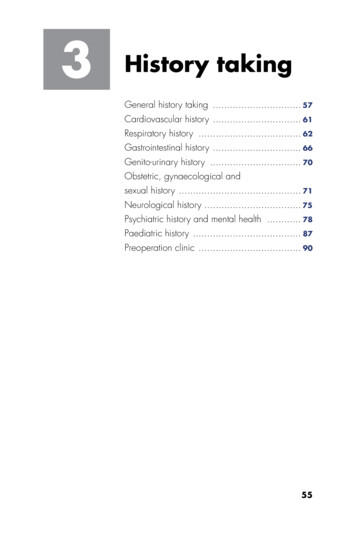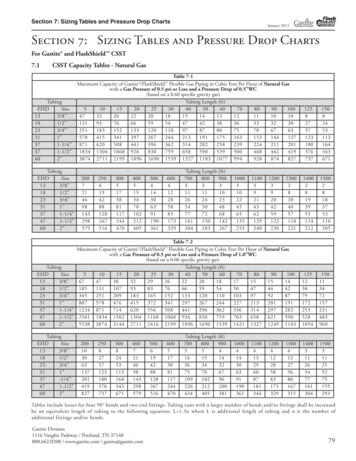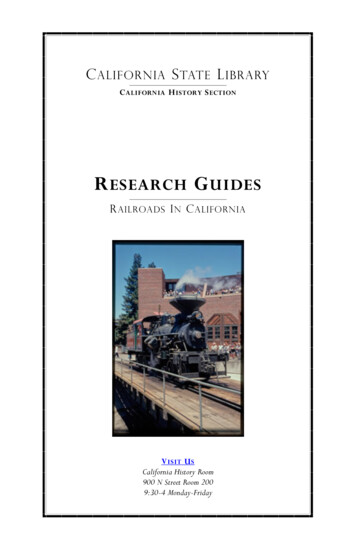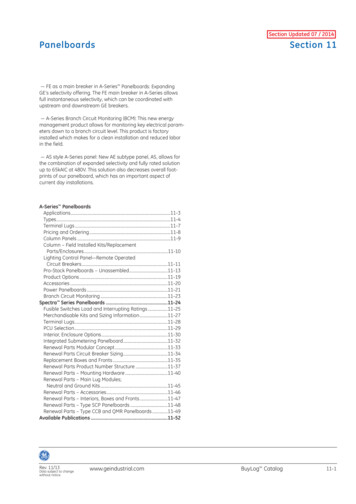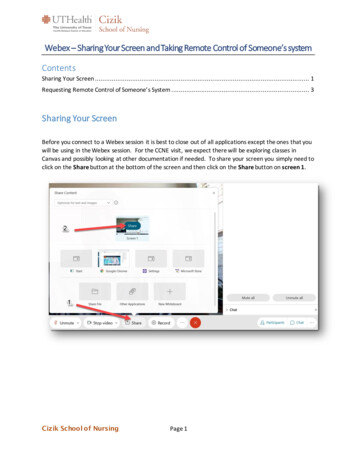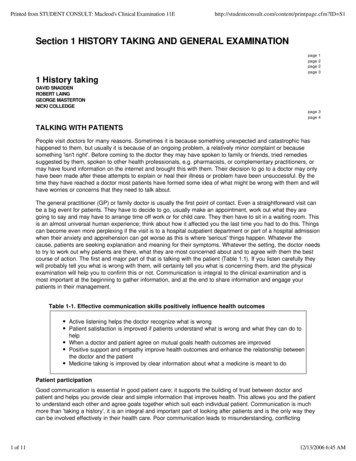
Transcription
Printed from STUDENT CONSULT: Macleod's Clinical Examination ?ID S1Section 1 HISTORY TAKING AND GENERAL EXAMINATIONpagepagepagepage12231 History takingDAVID SNADDENROBERT LAINGGEORGE MASTERTONNICKI COLLEDGEpage 3page 4TALKING WITH PATIENTSPeople visit doctors for many reasons. Sometimes it is because something unexpected and catastrophic hashappened to them, but usually it is because of an ongoing problem, a relatively minor complaint or becausesomething 'isn't right'. Before coming to the doctor they may have spoken to family or friends, tried remediessuggested by them, spoken to other health professionals, e.g. pharmacists, or complementary practitioners, ormay have found information on the internet and brought this with them. Their decision to go to a doctor may onlyhave been made after these attempts to explain or heal their illness or problem have been unsuccessful. By thetime they have reached a doctor most patients have formed some idea of what might be wrong with them and willhave worries or concerns that they need to talk about.The general practitioner (GP) or family doctor is usually the first point of contact. Even a straightforward visit canbe a big event for patients. They have to decide to go, usually make an appointment, work out what they aregoing to say and may have to arrange time off work or for child care. They then have to sit in a waiting room. Thisis an almost universal human experience; think about how it affected you the last time you had to do this. Thingscan become even more perplexing if the visit is to a hospital outpatient department or part of a hospital admissionwhen their anxiety and apprehension can get worse as this is where 'serious' things happen. Whatever thecause, patients are seeking explanation and meaning for their symptoms. Whatever the setting, the doctor needsto try to work out why patients are there, what they are most concerned about and to agree with them the bestcourse of action. The first and major part of that is talking with the patient (Table 1.1). If you listen carefully theywill probably tell you what is wrong with them, will certainly tell you what is concerning them, and the physicalexamination will help you to confirm this or not. Communication is integral to the clinical examination and ismost important at the beginning to gather information, and at the end to share information and engage yourpatients in their management.Table 1-1. Effective communication skills positively influence health outcomesActive listening helps the doctor recognize what is wrongPatient satisfaction is improved if patients understand what is wrong and what they can do tohelpWhen a doctor and patient agree on mutual goals health outcomes are improvedPositive support and empathy improve health outcomes and enhance the relationship betweenthe doctor and the patientMedicine taking is improved by clear information about what a medicine is meant to doPatient participationGood communication is essential in good patient care; it supports the building of trust between doctor andpatient and helps you provide clear and simple information that improves health. This allows you and the patientto understand each other and agree goals together which suit each individual patient. Communication is muchmore than 'taking a history', it is an integral and important part of looking after patients and is the only way theycan be involved effectively in their health care. Poor communication leads to misunderstanding, conflicting1 of 1112/13/2006 6:45 AM
Printed from STUDENT CONSULT: Macleod's Clinical Examination ?ID S1messages and patient dissatisfaction and is the root cause of many subsequent complaints and litigation.BeginningThat all sounds very well but how do you do it? (Table 1.2)Our personal experience of illness is unique and often difficult or embarrassing to explain. To make this easier foryour patient consider the following.Where will you see your patient?Table 1-2. BLISS: the stages of the y, summarize, contextInformation gatheringSystematic enquiryClinical examinationSharing informationChunk itCheck itShare decisionsSetting goalsEndingFollow-uppage 4page 5Ideally in a quiet, private space. This is usually easy in a GP surgery, but often difficult in hospital. In hospitaloutpatient departments nurses or students are often present, and in hospital wards privacy is often only affordedby curtains - which means no privacy at all. You must be sensitive to your patients' privacy and dignity in allcircumstances. If you are seeing the patient in a room and have others with you, for example junior colleagues,introduce them and ask permission for them to be there. If your patient is in a hospital bed but can get up, a sideroom or interview room may be used. Often there is no alternative to speaking to patients at their bedside, so letthem know that you understand that your conversation may be overheard and give them permission not to answersensitive things if they feel too uncomfortable about it.How long will you have?Consultation length varies. In general practice in the UK the average length is 10 minutes. This is usuallyadequate as the doctor may have seen the patient on several occasions and know the family and socialbackground. In hospital 5-10 minutes may be adequate for return outpatients, but for new and complex problemsmuch longer - 20-30 minutes - may be needed. If you are a student learning to talk with and examine patientsallow 30 minutes at least. Plan your time around how long you expect your patients to take so that others arenot kept waiting, and be prepared to be flexible.How will you sit?Arrange the seating in a non-confrontational way. If you use a desk, arrange the seats at the corner of the desk.This is less formal and helps communication (Fig. 1.1A, B). If you use a computer make sure the screen and2 of 1112/13/2006 6:45 AM
Printed from STUDENT CONSULT: Macleod's Clinical Examination ?ID S1keyboard do not get in the way or provide a distraction. Turn away from the screen to talk to your patient. If youare in a ward, pull up a chair and sit level with your patient (Fig. 1.1C). It is important that you can see yourpatient easily and gain eye contact.Non-verbal communicationFirst impressions are important. Your demeanour, attitude and dress influence your patient from the outset. At alltimes you need to be professional in dress and behaviour. This does not mean you need to be formal, but youmust be neat, clean and polite. Showing concern for your patient's situation is important.Pick up non-verbal cues from your patients. Are they distressed? What is their mood like and how do theirdemeanour and body language change during the consultation? This gives clues to difficulties they are havingthat they cannot express verbally. If people are getting uncomfortable during a line of questioning their bodylanguage may become 'closed', i.e. they may cross their arms and legs and fail to keep eye contact.Starting the consultationFigure 1.1 Seating arrangements. (A) The desk as a defence mechanism. (B) A more appropriate arrangement of doctor and patientdesigned to put the patient at ease. (C) Appropriate arrangement of doctor and patient for a bedside interview.page 5page 6Before starting, make sure you are talking to the correct patient. Introduce yourself, as your patients shouldknow who you are and what you do. If you are in training, tell them, as patients are usually eager to help. It helpsto create a good impression if you appear to have prepared to see them. Look at the patient records and at anytransfer or admission letters before the consultation. It is easier to give your patient your attention if you do notwrite notes during the consultation, but you may have to write some things, e.g. blood pressure readings orfamily trees, which are easily forgotten. If you are going to take notes let your patient know.Throughout this part of the chapter there are examples of a doctor and a patient talking with each other. Theseare only illustrations, not hard and fast rules. Remember that it is the principles of communication that areimportant. If you get the principles right, then the words you use will change depending on the situation. To beginwith, here are a few ideas on how to get an interview going.Good morning Mrs Jones, I have got the right person haven't I? I am Mr Brown. Iam a fourth year medical student. I've been asked if I could come and talk to youand examine you as you have just come into the ward today. Is that OK?It might take me 20-30 minutes if that is alright with you.I would like you to tell me what has been happening and then I'll want to ask a fewquestions and examine you.3 of 1112/13/2006 6:45 AM
Printed from STUDENT CONSULT: Macleod's Clinical Examination ?ID S1I see that you can't really get out of bed so I am afraid we'll need to talk here. I'llpull the screens round, but I'm sorry it is not that private, so if I ask you anythingthat you don't want to tell me in case others hear then just say so.Because I'll have to get quite a bit of information from you, I'll need to make a fewnotes. I hope that is alright because I'll forget otherwise. Now if I am writing thingsdown it doesn't mean I'm not listening to you, I still will be.Are you happy with all that?ListeningThe patient's own story is vital. Ask patients to tell you what has happened to bring them into the hospital, or, ifin the community, try 'How can I help you today?' or 'What has brought you along to see me today?' Patientsknow doctors are busy and most will tell you their problem within 1-2 minutes so do not interrupt.This first stage is 'active listening'. This means encouraging patients to talk by looking interested, makingencouraging comments or noises, e.g. 'tell me a bit more' or 'uhuh', and giving them the impression that you havetime for them. Active listening is used to gather information. Also, it allows them to tell their story in their ownwords. This might not make complete sense to you, so you may have to ask for 'clarification'. To do this askthem to explain a bit more about their symptoms. You can also tell them what you think they have said and askif your interpretation is correct.Can we start with you telling me what has happened to bring you into hospital?(Opening)Well doctor, I have been getting this funny feeling in my chest over the last few months.It's been getting worse and worse till it got to the point today I had to call my GP and hesent me in. It was really awful this morning, I got really breathless and felt someone wasstanding on me.Tell me a bit more about the feeling in your chest. (Open questioning)Well it was here, across my chest, it was sort of tight and I was sweaty.And did it go anywhere else? (Clarifying)No, well maybe up here in my neck a bit.So what you are saying is that you had this pain in your chest this morning thatwent on a long time - how long do you think? (Summarizing and clarifying)Oh, a couple of hours.And the pain was tight and up into your neck. How is it now? (Open questioning)Oh it is not bad, the injections I had seem to have put it away.OK, now you said that you had had the pain for the last few months. Can you tellme more about that? (Open questioning)Well it was the same but not that bad, though it has been getting worse recently.OK, can you remember when it first started? (Clarifying)Oh 3 or 4 months ago.And how often has it been coming? (Open questioning)To start with just now and again, but in the last 2 to 3 weeks, probably every dayanyway.Does anything makes it worse? (Open questioning)Well if I go up steps or up hills that can bring it on.What do you do?4 of 1112/13/2006 6:45 AM
Printed from STUDENT CONSULT: Macleod's Clinical Examination ?ID S1Stop and sometimes take my puffer.Your what? (Clarifying)This spray the doctor gave me to put in my mouth.Can you show me it please?OK.And what does it do? (Clarifying)Well it takes the pain away, but I get an awful headache with it.OK, so for a few months you have had this tightness in your chest, which getsworse on going up hills and upstairs and which goes away if you use your spray.But today it came on and lasted a couple of hours but felt the same. Have I got thatright? (Summarizing)No, it was much worse this morning.page 6page 7Once you have established what has happened, find out the patient's 'ideas', 'concerns' and ts will have thoughts and feelings about what has happened to them which may or may not be accurate,but which can help you. For instance, a patient with chest pain might think he has indigestion while you areconsidering angina. This can cause confusion so ask 'Do you have any thoughts about what might be happeningto you?' A young mother bringing her child to the doctor with a sore throat may only want reassurance, notmedicine. A simple question like 'What were you thinking I might do today?' can get surprising answers andavoid unnecessary prescriptions or investigations.The way you ask a question is important. Open questions encourage the patient to talk. Closed questions seekspecific information as part of a systematic inquiry. Both have their place. Open questions usually start with aword like 'where' or 'what', or a phrase like 'tell me more about ', and are more useful at the beginning when youare trying to find out what is going on and to encourage the patient to talk. Closed questions, e.g. 'Have you beensick today?' invite yes or no answers.Exploring your patient's contextIllness never happens in isolation. The context of our lives has a major influence on how we deal with illness. This
1 History taking DAVID SNADDEN ROBERT LAING GEORGE MASTERTON NICKI COLLEDGE page 3 page 4 TALKING WITH PATIENTS People visit doctors for many reasons. Sometimes it is because something unexpected and catastrophic has happened to them, but usually it is because of an ongoing problem, a relatively minor complaint or because something 'isn't right'. Before coming to the doctor
